Enterprise IT infrastructure and IT resources investments are influenced by the increase of IoT data. Shifts in IoT data strategies and technologies such as edge computing, analysis at the edge and even more IoT data move the needle from data centers to cloud and network edge equipment.
IoT is changing both the IT (information technology) and OT (operational technology) landscape with the integration of IT and OT and, especially, with the increasing deluge of IoT data changing technological paradigms and impacting IT infrastructure. IoT data and IT infrastructure – state and outlook 2018 and a bit of 2019.
While some enterprises say that in the future they will do more analytics – including heavy data processing and analysis driven by big data or AI – at the network edge, for now that deeper analysis is happening in company-owned data centers or in the public cloud (Rich Karpinski, 451 Research)
Is there something that is not affected by IoT and related technologies and the impact of the ways they are combined and leveraged? We’re not talking about industries, applications or IoT use cases for a change but about the technological landscape and, more particular, IoT data and the IT infrastructure.
With IoT, IT infrastructure and the overall IT landscape as such is complemented. We have a broad range of new hardware, software, connectivity solutions and services, that seems obvious. From software such as IoT platforms and hardware such as all the smart ‘things’, the sensors, the actuators, IoT gateways or IoT edge devices to a bunch of predominantly wireless IoT connectivity solutions, a big market of new services on top of service platforms and service providers and new ways to process and analyze IoT data such as edge computing.
What they all have in common are obviously the many aspects of ever more IoT data and how to get, leverage and combine them to turn them in good old actionable intelligence and, more importantly, into intelligent actions and outcomes (DIKW).
However, IoT and IoT data are not just adding to our IT infrastructure, IoT is also impacting the existing IT infrastructure as much as it is affecting the overall landscape of technologies and solutions. And then there are all the technological aspects regarding IT and OT convergence and new technological possibilities that arise once you start combining IoT, AI and big data analytics to name a few. Yes, again that boils all down to data.
In this article we mainly take a look at where IoT is impacting existing technologies and IT infrastructure and leading to higher IT infrastructure and resources spending or changing spending priorities. Just looking at all what is needed to handle, process, store, analyze, let alone fully leverage, monetize or utilize the sheer volume of IoT data for myriad possible applications, one sees how far it all stretches.
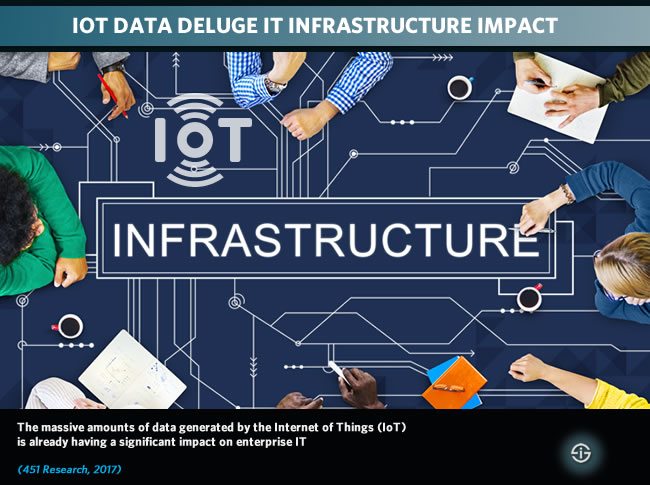
How IoT and IoT data change the overall technology landscape
Moreover it is not just about the spend and priorities regarding IoT and IT infrastructure (did we mention security and privacy yet?) but also about how IoT and certainly IT and OT integration are disrupting technology solutions that have existed since like forever.
Let’s just look at some examples in the more software-oriented space (although there are is hardware and there are services, cloud and so forth coming with that software). If you look at the evolutions of building management in the age of IoT you see how building management systems are becoming the hub of the smart building. Thank IoT, IoT data and related technologies and possibilities for that.
Organizations deploying IoT are planning increases in storage capacity (32.4%), network edge equipment (30.2%), server infrastructure (29.4%) and off-premises cloud infrastructure (27.2%) in the next 12 months, to help manage the IoT data storm (451 Research, Summer 2017)
Or take manufacturing: IoT, again the integration of IT and OT and, indeed again, associated technologies and evolutions to leverage IoT and other data with a purpose are, according to IDC, about to disrupt ERP with intelligent ERP. The evolutions in the manufacturing environment where we find solutions such as manufacturing execution systems (MES) and thus MES software and SCADA systems and thus SCADA software, are all influenced by Industrial IoT, IoT and the broader technological picture of what is known as Industry 4.0.
It doesn’t stop there. Smart supply chain management, smart this, smart that; all across various industries, including less OT-intensive ones than those just mentioned, IoT and all the related digital transformation technologies and, more importantly, priorities and goals change existing solutions, practices, vendor strategies and the overall enterprise IT architecture.
IoT data deluge? You ain’t seen nothing yet
Leaving OT and specific industries aside, time for a look at the IoT IT infrastructure perspective. It is clear that the impact of IoT on that IoT infrastructure is mainly one with regards to the impact of massive IoT data amounts as generated through IoT on enterprise IT.
However, that is just the beginning. Although the number of large scale IoT projects doubled in a year (with large meaning many devices and loads of IoT data), we are only really in the early days of those volumes of data generated by IoT, despite IoT having become a business reality.
And even in environments such as oil and gas or those really big manufacturing operations where loads of IoT data are gathered, the real big IoT data generators are still to come: life sciences is one. Last but not last, companies that collect IoT data often use a very tiny percentage of them today and store the rest, the so-called dark data.
On top of ever more IoT data: the increasing usage of unused data
We previously mentioned an example: McKinsey found (PDF opens) that in one case on an oil rig with 30,000 sensors only one (1!) percent of the data was examined and 99 percent of data collected was lost before reaching operational decision makers.
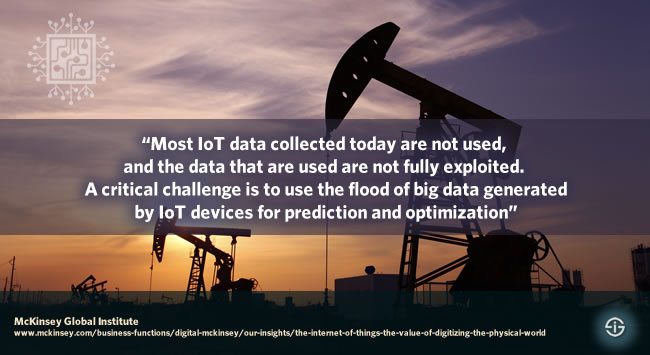
The reason: the rest of the IoT data never made it from the rig. The bigger context behind the overall finding was that little data is actually used in that particular industry (and many others): the data gets gathered to serve a specific purpose, namely detecting, controlling and solving issues with regards to, for example, discrete machines or systems. With interoperability alone (e.g. between the rig, the manufacturers of equipment and various other IoT systems) a lot more could be done and a lot more value and efficiency could be achieved.
Even if the mentioned McKinsey report where the statement was made goes back a few years do trust us when we say that the statement of McKinsey that “Most IoT data collected today are not used, and the data that are used are not fully exploited. A critical challenge is to use the flood of big data generated by IoT devices for prediction and optimization” still is valid.
It’s exactly what you will read further in this article as we look at IoT data usage and processing from an IT infrastructure and IoT project scope perspective as found in 2017 with some evolutions in 2018 and 2019 on top. Once you start leveraging the unused, dark data, for other purposes which go beyond immediate goals to serve higher-value goals such as predictive applications and actionable intelligence in the scope of whatever human, semi-autonomous or autonomous decision process or even new business models or revenue sources, when combining with other data and/or with the data of others through IoT data exchanges, there is real value at stake in – at least a portion – of that xyz percent of remaining data.
Aggregating IoT data and other data from various source
Needless to say that this also comes with an impact on IT infrastructure requirements (and on data sovereignty, data privacy, security and regulations, marketplaces and ecosystems revolving around IoT data aggregation and exchanges where some see blockchain coming in and others work on things like the Industrial Data Space where data sovereignty takes center stage as previously written).
Collection, storage, transport and analysis of IoT data is impacting all aspects of IT infrastructure (451 Research, Summer 2017)
We can even take it several steps further. As mentioned in our article on key IT evolutions enabling digital transformation in 2018 and beyond, we see this ever increasing combination and integration on not just the level of IoT data but of all types and sources of data whereby we mentioned the example of life sciences and pharma where hospital data, IoT data (wearables), medical research data and, the big one, genetic data, all get integrated to find new healthcare solutions. Imagine the impact on your IT infrastructure here….
However, regardless of the fact that the IoT data deluge and, in general, the data explosion of mainly unstructured data we have now is nothing compared to what’s coming and there is still a lot to do with data we have and still haven’t aggregated or leveraged yet, IoT and the IoT data explosion as we know it today is already felt on IT infrastructure in pretty big ways.
The IoT data deluge is still a storm but IoT impacts IT infrastructure here and now
And that brings us to a September 2017 research announcement that shows just how much IoT, and especially IoT data, is impacting IT infrastructure from edge to the cloud.
It isn’t just interesting research from the perspective of the sheer impact of IoT data on IT infrastructure as it stands end 2017 but also about how IoT data flows and has consequences across the whole environment, from the utterly decentralized edge of edge computing and fog computing to the centralized environments within which IoT data reside and get leveraged.
IoT IT infrastructure spending impact

According to a press release (PDF opens) from 451 Research, which looked at the impact of IoT on IT infrastructure, from edge to cloud, organizations which are deploying IoT projects (of course depending on the type of project or use case; you can imagine a large IIoT deployment is not the same as a limited smart city IoT deployment in a particular scope such as smart streetlighting or urban air quality monitoring where we often see that LPWAN suffices as there is little data needed and it is sensed and sent with intervals) on average plan to increase storage capacity.
With 32.4 percent of respondents planning to do so, the increase of storage capacity also ranks highest as an IT infrastructure and IT resources measure driven by IoT projects.
As the graphic from the press release below shows, storage capacity is followed by network edge or perimeter equipment with 30.2 percent of respondents, which in turn is followed by server infrastructure that ranks third with 29.4 percent.
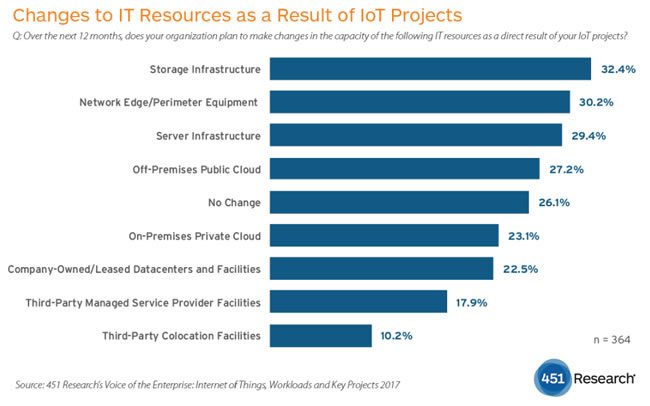
Next comes off-premises public cloud infrastructure to tackle, as 451 Research calls it, the IoT data storm.
Note: the results concern thee plans to make changes in IT infrastructure and the capacity of IT resources (whereby respondents could choose from a list) for the 12 months after the survey and as a result of IoT projects alone.
Surprisingly, little over 26 percent sees no changes at all (maybe because the needs aren’t that big, give, the previously mentioned many different types of IoT projects and thus capacity needs and maybe also because, well, capacity enough).
Other areas include on-premises private cloud (23.1 percent), company-owned or leased data centers and facilities (22.5 percent), third party managed service provider facilities (17.9) and, finally, third-party colocation facilities (10.2).
IoT data from data center and cloud to edge: where IoT data comes and goes in the enterprise IT infrastructure – and why
As said the announcement of the research (and thus the research, entitled ‘Voice of the Enterprise: IoT – Workloads and Key Projects‘) also looks at IoT data from edge to cloud and where what happens and impacts specific areas of the IT infrastructure when (remembering that all IT infrastructure areas are affected).
The majority of organizations initially stores and analyze IoT data at a company-owned data center the press release says. IoT data remains stored in that data center for about two-thirds of responding organizations and only one-third moves it to a public cloud. Cloud storage mainly seems to offer the flexibility and long term cost savings when there is a higher focus on historical use cases such as trend analysis and reporting duties from a regulation perspective. Yet, when it concerns real-time use cases and operational ones IoT data nicely sites in the data center for most and only goes cloud when companies go beyond these use cases towards, for example, the mentioned historical ones.
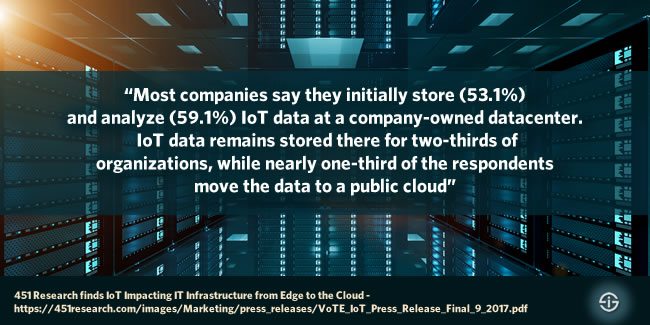
In other words: quite some centralization. It is most certainly also related with the nature of the use cases for which IoT projects are launched to begin with and, as we know, gradually shift to higher value goals of which trend analysis is only one. You can imagine that when IoT data enters the exchange and innovation stages by definition we are talking cloud as that’s where IoT monetization, data exchange and other platforms play.
IoT data and IT infrastructure at the edge – facts and future
By now you probably wonder ‘what about the edge’? With edge computing and, in general the shift of intelligence to the edge, being on the predictions lists of close to all analysts and being on the real-life evolutions list in many use cases and industries, edge computing (and fog computing) are what everyone talks about. Moreover, from an IoT infrastructure and resources perspective it makes sense to analyze at the edge (the source), right?
First of all we need to remind that it’s not about cloud versus edge or cloud versus fog as we read now and then. Secondly, we also need to remind that as written previously edge computing nor Cisco’s fog computing are useful in all circumstances and projects.
And finally, as the survey of 60,000 senior IT buyers which led to the “Voice of the Enterprise: Internet of Things – Workloads and Key Projects 2017 study” shows little under half of respondents are doing IoT data processing, which includes IoT data analysis, IoT data aggregation and IoT data filtering, at the edge: either on the IoT device (22.2 percent of respondents) or in nearby IT infrastructure (23.3 percent). As Research Director Rich Karpinski puts it in the press release “companies are processing IoT workloads at the edge today to improve security, process real-time operational action triggers, and reduce IoT data storage and transport requirements”. Yet, that is poised to evolve over time as, among others, organizations do more heavy data processing and analysis, driven by big data or AI, adding to what is done at the edge.
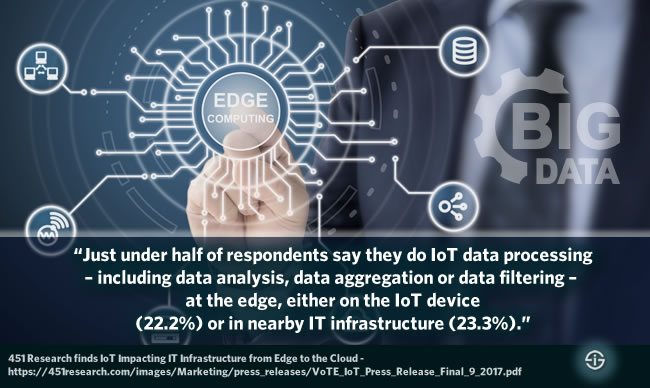
IoT spending, challenges and use cases 2018
Finally a few words on the state and expectations regarding IoT and IoT projects for 2018 (or, more precisely for the next 12 months after the survey was conducted).
The research found that spending on IoT projects as such remains high with 65.6 percent of respondents intending to increase IoT project spending and only 2.7 percent planning the opposite.
IT-centric projects are the dominant IoT use cases, particularly datacenter management and surveillance and security monitoring. Two years out, however, facilities automation will likely be the most popular use case, and line-of-business-centric supply chain management is expected to jump from number 6 to number three. (451 Research, Summer 2017)
One of the major challenges remains finding IoT-skilled workers whereby almost 50 percent of respondents state they are facing a skills shortage in the context of IoT-related tasks and functions with data analytics, security and virtualization capabilities being the skills that are most in demand.
Looking at the IoT use case perspective, most of them are IT-centric. However, by somewhere in the second half of 2019 facilities automation is expected to be the main IoT use case with line-of-business-centric (smart) supply chain management jumping to the third spot by then (now at 6).
More in the mentioned press release and of course in the 451 Research Voice of the Enterprise: IoT – Workloads and Key Projects 2017 which was finalized in the Summer of 2017.
Top image: Shutterstock – Copyright: Rawpixel.com – McKinsey quote image: Shutterstock – Copyright: pan demine – datacenter image: Shutterstock – Copyright: sdecoret– datacenter image: Shutterstock – Copyright: BeeBright – Icon set: Shutterstock – Copyright: Panchenko Vladimir – All other images are the property of their respective mentioned owners.






